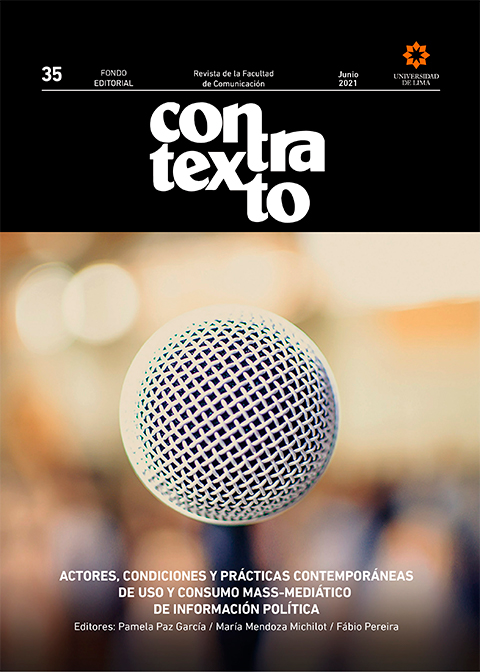Representación periodística de mujeres en el reportaje de operaciones militares contra Boko Haram en el noreste de Nigeria
DOI:
https://doi.org/10.26439/contratexto2021.n035.4826Palabras clave:
género, noticias, Boko Haram, militar, NigeriaResumen
En este estudio se investigó el papel de las mujeres en la información sobre operaciones militares contra los insurgentes de Boko Haram y su representación en los informes de noticias. La teoría del feminismo radical y la teoría de grupos silenciados feministas se utilizaron para dilucidar la investigación. Mediante el análisis de contenido de las ediciones en línea de cuatro periódicos nigerianos: Daily Trust, Premium Times, The Nation, y Vanguard, de enero del 2014 a diciembre del 2016 fueron investigados para revelar cómo se presentaba a las mujeres en los informes de noticias. Los hallazgos produjeron 185 historias noticiosas; las mujeres se incluyeron en el 10 % del total de fotografías utilizadas. Las mujeres constituían el 8 % de los firmantes y el 4 % de las fuentes, con el 59 % de las mujeres mencionadas en las noticias presentadas como secuestradas y rescatadas. El estudio encontró una subrepresentación y tergiversación de las mujeres en los informes de noticias que se atribuyeron al campo del periodismo dominado por hombres que prefería usar sus fuentes masculinas en detrimento de los problemas que afectan a las mujeres.
Descargas
Referencias
Ahokegh, A.F. (2012). Boko Haram: A 21st century challenge in Nigeria. European Scientific Journal, 8 (21), 46–55.
Alli, C. (2001). The Federal Republic of Nigerian Army: The siege of a nation. Lagos: Malthouse Press Limited.
Amobi, I. (2013). Portrayal and participation of women in Nigerian media. Retrieved from https://profteri.wordpress.com/2013/07/27/portrayal-and-participation-of-women-in-nigerian-media/
Anorue, L.I., Obayi, P.M., & Onyebuchi, C.A. (2012). The Mass Media, Gender Balance and Politics in Nigeria: An Assessment. AFRREV LALIGENS, 1 (3), 14-35.
Anyanwu, C. (2001) In Nigerian Newspapers, Women Are Seen, Not Heard: Even Influential Women Journalists stay away from Coverage of Women’s Issues. Retrieved from https://niemanreports.org/articles/in-nigerian-newspapers-women-are-seen-not-heard/
Ashong, A.C. & Batta, H. E. (2011). Gender and representation in communication education and practice in Nigeria. J Communication, 2(1): 13-22.
Awokoya, A. (2019). Women at war: what is it actually like being a female reporter on the frontline? Retrieved from https://www.gq-magazine.co.uk/article/female-war-reporters
Ayetoto, T. (2018). Nigeria plunges to 133rd on Gender Index as women shrink in economy, politics. Retrieved from https://businessday.ng/exclusives/article/nigeria-plunges-to-133rd-on-gender-index-as-women-shrink-in-economy-politics/
Bakare, T. (2018). Tackling gender disparities as Nigeria stagnates on the Global Gender Gap table. Retrieved from https://guardian.ng/features/tackling-gender-disparities-as-nigeria-stagnates-on-the-global-gender-gap-table/
Bigio, J. & Vogelstein, R. (2019). Women and terrorism: Hidden threats, forgotten partners. Council on Foreign Relations. Retrieved from https://www.cfr.org/report/women-and-terrorism
Deutch, G. (2019). In the ‘Year of the Woman,’ many were missing from international reporting. Retrieved from https://www.theatlantic.com/international/archive/2019/02/gender-bias-persists-international-reporting-atlantic/582235/
Djerf-Pierre, M. (2007). The gender of journalism: The structure and logic of the field in the twentieth century. Nordicom Review, Jubilee Issue, 81-104.
Dow, B. J. & Condit, C. M. (2005). The state of the art in feminist scholarship in communication. Journal of Communication, 55, 448–478.
Enwefah, C. (2016). Gender representation in the editorial and repotorial staff of newspapers in Nigeria. Global Journal of Human-Social Science, 16(1), 16-21.
Fab-Ukozor, N. T. (2004). Gender, politics and conflict resolution in Nigeria: Beyond rhetorics. In Communication, media and conflict management in Nigeria, edited by I. E. Nwosu and D. Wilson. Enugu: ACEE (Nigeria) & Prime Target Limited.Guaglione,
S. (2019). Study: despite rising numbers of female journalists, men dominate news bylines. Retrieved from https://www.mediapost.com/publications/article/332350/study-despite-rising-numbers-of-female-journalist.html
Hines, S. (2008) ‘Feminist Theories’ in Richardson, D. and Robinson, V. (eds.) Introducing Gender and Women’s Studies, 3rd ed., Basingstoke: Palgrave Macmillan, 20-34.
Idowu, K. (2016). Female fighters who risk their lives battling Boko Haram. Retrieved from https://punchng.com/female-fighters-risk-lives-battling-boko-haram/
International Crisis Group (2016). Nigeria: Women and the Boko Haram Insurgency. Africa Report No. 242. Retrieved from https://www.crisisgroup.org/africa/west-africa/nigeria/nigeria-women-and-boko-haram-insurgency
Ityavyar, D. A. (1992). The changing socio-economic role of Tiv women. Jos: Jos University Press Ltd.
Jones, K.C. & Budig, M.J. (2008). Feminist Theory. In V.N. Parrillo (Ed.). Encyclopedia of social problems. Thousand Oaks: Sage
Joyce, A. (2014). Is journalism really a male-dominated field? The numbers say yes. Retrieved from https://www.washingtonpost.com/news/style/wp/2014/05/20/is-journalism-really-a-male-dominated-field-the-numbers-say-yes/
Kramarae, C. (1981). Women and men speaking. Rowley, MA: Newbury House Publishers.
Matfess, H. & Warner, J. (2017). Exploding stereotypes: The unexpected operations and demographic characteristics of Boko Haram’s suicide bombers. Combatting Terrorism Center. Retrieved from https://ctc.usma.edu/report-exploding-stereotypes-the-unexpected-operational-and-demographic-characteristics-of-boko-harams-suicide-bombers/
Mlambo-Ngcuka, P. & Coomaraswamy, R. (2015). Women Are the Best Weapon in the War Against Terrorism. Retrieved from https://foreignpolicy.com/2015/02/10/women-are-the-best-weapon-in-the-war-against-terrorism/
Nwabueze, C. (2012) Fact or farce? Female journalists’ perceptions of gender relations and underrepresentation in the Nigerian media. Catalan Journal of Communication and Cultural Studies, 4 (2), 221-237.
Nweke, T. (1989). Women in Nigerian Society: The Media Women in Nigeria Today. London: Zed Books.
Okeowo, A. (2015). The women fighting Boko Haram. Retrieved from https://www.newyorker.com/news/news-desk/the-women-fighting-boko-haram
Okoli, A.C. (2019). Boko Haram insurgency and gendered victimhood: women as corporal victims and objects of war. Small Wars and Insurgencies, 30(6-7), 1214-1232.
Okon, G. B. (2013). The Niger Delta Crises and advocacy for peace by the Nigerian press: A content analysis of three Nigerian newspapers. New Media and Mass Communication, 1(14), 7-17.
Okon, G. B. (2017). The Rivers state rerun election and print media content on matters arising: A performance appraisal. Review of Communication and Media Studies, 1(4), 1-18.
Okunna, C.S. (2002) Gender and Communication in Nigeria: Is this the Twenty-first Century? Retrieved from https://www.semanticscholar.org/paper/GENDER-AND-COMMUNICATION-IN-NIGERIA-%3A-IS-THIS-THE-Okunna/ea041961f8c3d3d1aa0b98e14102047ab626ef58
Oppenheim, M. (2019). Male journalists report majority of US news and dominate prime time TV slots. Retrieved from https://www.independent.co.uk/news/world/americas/male-journalists-us-media-news-tv-slots-womens-media-center-a8758916.html
Pillay, A. (2018). Harnessing Gender Transformative Opportunities within Humanitarian Crises: A Field Note from North-east Nigeria. Retrieved from https://www.accord.org.za/conflict-trends/harnessing-gender-transformative-opportunities-within-humanitarian-crises/
Ponsford, D. (2017). Study finds little change in five years as male bylines dominate UK national newspaper front pages. Retrieved from http://www.pressgazette.co.uk /study-finds-little-change-in-five-years-as-male-bylines-dominate-uk-national-newspaper-front-pages/
Reporters Without Borders (2016). Daily abuses suffered by Nigeria’s journalists. Retrieved from https://rsf.org/en/news/daily-abuses-suffered-nigerias-journalists
Rozen, J. (2019). You cannot muzzle the media’: Nigerian journalists on press freedom under Buhari. Retrieved from https://reliefweb.int/report/nigeria/you-cannot-muzzle-media-nigerian-journalists-press-freedom-under-buhari
Sunday, O. (2019). The brave women fighting Boko Haram in Nigeria. Retrieved from https://www.aljazeera.com/news/2019/07/brave-women-fighting-boko-haram-nigeria-190710054934577.html
Ukpong, C. (2018, May 9). Boko Haram: #BringBacjOurGirls group raises questions over Army’s claim of rescuing 1,000 people. Premium Times. Retrieved from https://www.premiumtimesng.com/news/top-news/267835-boko-haram-bringbackourgirls-group-raise s-questions-over-armys-claim-of-rescuing-1000-people.html
UNICEF (2019). Celebrating women humanitarians on the front lines for UNICEF. Retrieved from https://www.unicefusa.org/stories/celebrating-women-humanitarians-front-lines-unicef/36236
UN Office for the Coordination of Humanitarian Affairs (OCHA) (2019). Nigeria pays tribute to women aid workers on World Humanitarian Day. Retrieved from https://reliefweb.int/report/nigeria/nigeria-pays-tribute-women-aid-workers-world-humanitarian-day
West, R.L. & Turner, L.H. (2018). Introducing communication theory: Analysis and application (6th ed.). New York: McGraw-Hill Education.
Women Media Center (2017). Women’s Media Center Report: Women journalists report less news than men; TV gender gap most stark. Retrieved from http://www.womensmediacenter.com/about/press/press-releases/womens-media-center-report-women-journalists-report-less-news-than-men-tv-g
Wood, J.T. (2005) Feminist Standpoint Theory and Muted Group Theory: Commonalities and Divergences. Women and Language, 28, 61-64.
World Economic Forum (2020). Global Gender Gap Report 2020. Retrieved from https://www.weforum.org/reports/gender-gap-2020-report-100-years-pay-equality
Yamane, T. (1973). Statistics: An introductory analysis. New York: Harper and Row.
York, C. (2017). Women dominate journalism schools, but newsrooms are still a different story. Retrieved from https://www.poynter.org/business-work/2017/women-dominate-journalism-schools-but-newsrooms-are-still-a-different-story/
Zena, E. (2019). (Impossible) Women and Boko Haram: The Paradox of Female Support to Sharia Law. Retrieved from https://www.e-ir.info/2019/02/17/impossible-women-and-boko-haram-the-paradox-of-female-support-to-sharia-law/
Descargas
Publicado
Número
Sección
Licencia
Todos los trabajos publicados están sujetos a una licencia CC BY 4.0 Creative Commons (actualizado el 1 de marzo de 2021).
El contenido de la revista se puede compartir en cualquier material o formato. Asimismo, se puede adaptar, contribuir y transformar. Ambas posibilidades sólo están permitidas en la medida en que cumplan las siguientes condiciones:
- Atribución: Se debe otorgar crédito donde sea debido, proporcionar un enlace a la licencia e indicar los cambios en caso se realice alguno. Esto debe hacerse de la manera que se considere apropiada, sin sugerir que el licenciante lo promueva a usted o su uso del material.
Derechos de propiedad
Los derechos patrimoniales de Contratexto se publican bajo una licencia Creative Commons BY 4.0, lo que permite a los autores mantener los derechos patrimoniales de su obra sin restricciones.
Si un trabajo publicado en Contratexto fuera copiado, distribuido, difundido o cualquier otra actividad contemplada en la licencia antes mencionada, se deberá mencionar de manera visible y expresa al autor o autores y a la revista.
Auto-archivo
Esta revista permite y anima a los autores/as a publicar artículos enviados a la revista en sus sitios web personales o en depósitos institucionales, tanto antes como después de su publicación en esta revista, siempre y cuando proporcionen información bibliográfica que acredite, si procede, su publicación en ella.


















